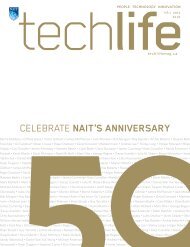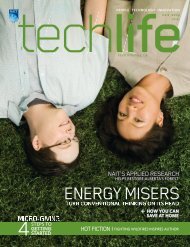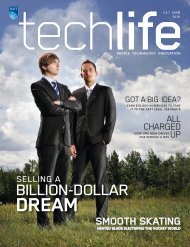CUBA'S - techlife magazine
CUBA'S - techlife magazine
CUBA'S - techlife magazine
Create successful ePaper yourself
Turn your PDF publications into a flip-book with our unique Google optimized e-Paper software.
illustration by jennifer lubrin<br />
[ GADGETS ] pLug Your ears<br />
You’re mowing the lawn when your neighbour pops his head over the fence to say hi. he’s an arm’s length away,<br />
but you can barely hear him because of the motor. sound familiar? chances are, you haven’t thought about what<br />
that noise means for your hearing. “most people don’t give hearing protection at home much consideration,”<br />
says Jodi howick, chair of nait’s occupational health and safety program. “but the impacts of noise are the same,<br />
no matter where the exposure is experienced.” here, howick gives a primer on protecting your hearing.<br />
— Kristen Vernon<br />
when to wear hearing protection “From an<br />
occupational perspective, Alberta legislation requires<br />
hearing protection if noise levels are above 85 dBA over<br />
an eight-hour time period,” says Howick. “But a good<br />
general test is if you have to raise your voice to speak<br />
to someone an arm’s length away.” If your ears ring or<br />
sounds seem muffled after exposure – even temporarily<br />
– you needed protection.<br />
earplugs or earmuffs? “This is really a matter of choice<br />
as long as the protection fits and is worn properly,”<br />
Howick says. “We want to reduce the noise level<br />
to between 70 and 85 dBA when we have hearing<br />
protection on.” Less than 70 is considered overprotection,<br />
which may prevent you from hearing safety alerts.<br />
To know you’re reducing to an acceptable level,<br />
use what’s called the Noise Reduction<br />
Rating (NRR), which is clearly<br />
indicated on earplugs and<br />
earmuffs available<br />
at the local<br />
hardware store.<br />
how long<br />
you can be<br />
exposed<br />
without<br />
protection<br />
lawnmower<br />
85 to 95 dBA<br />
88 dBA<br />
food blender<br />
Snow blower<br />
85 to 91 dBA<br />
electric drill<br />
94 dBA<br />
Rock concert<br />
90 to 115 dBA<br />
leaf blower<br />
110 to 112 dBA<br />
home stereo<br />
up to 115 dBA<br />
HIgH def<br />
d•B•A<br />
Sound intensity is measured<br />
in decibels (dB). The A-scale<br />
accounts for how the ear<br />
perceives loudness.<br />
It is expressed as dBA.<br />
85 dBA for 8 hours 88 dBA for 4 hours 91 dBA for 2 hours 94 dBA for 1 hour 97 dBA for 30 minutes 100 dBA for 15 minutes 109 dBA for 2 minutes > 115 dBA for 0 minutes<br />
> 110 dBa<br />
use both<br />
earplugs<br />
& muffs<br />
Inside the<br />
average<br />
home<br />
50 dBa<br />
Because the NRR is based on ideal lab conditions,<br />
follow these steps to determine the true dBA level with<br />
hearing protection for your situation.<br />
1. Use these formulas to revise the NRR number<br />
• Earmuffs: reduce the manufacturer’s NRR<br />
by 25 per cent and then subtract seven.<br />
• Formable earplugs: reduce the manufacturer’s<br />
NRR by 50 per cent and then subtract seven.<br />
• All other earplugs: reduce the manufacturer’s<br />
NRR by 70 per cent and then subtract seven.<br />
2. Determine the true dBA level with hearing protection<br />
by subtracting the revised NRR from the known dBA<br />
level for the activity.<br />
When to protect your hearing<br />
up to 125 dBA<br />
Chainsaw<br />
0 50 110<br />
dBa Range<br />
TECHNOfILE<br />
v4.2 2011 21










